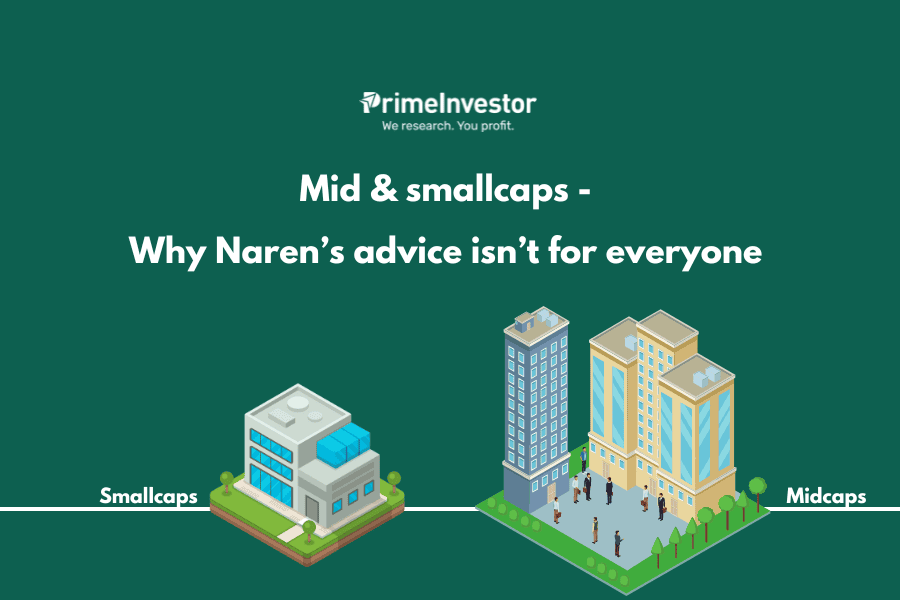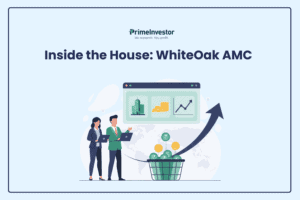When stock markets tumble and test one’s conviction, investors look for external cues on what to do next. In such times, even routine warnings by market gurus can get amplified out of proportion.

This seems to be the main reason why the investing community is in such a tizzy over remarks by Sankaran Naren, CIO of ICICI Prudential Mutual Fund at a recent industry event.Mr Naren has partially watered down some of his observations since. But we have received panicked queries from some of you on whether you should be stopping SIPs in mid-cap and small-cap funds, and redeeming all holdings before they fall further.
For those who don’t want to read any further, here’s our answer.
- No, you should not stop SIPs in mid-cap and small-cap funds. The very purpose of SIPs is to average your entry prices lower if markets fall. SIPs also help you acquire meaningful positions in funds without having to find large lumpsums to invest.
- Yes, you should book some profits on your mid-cap and small-cap funds, if your allocations to these categories have exceeded your originally set limits. Mid-cap and small-cap funds provide outsized returns in bull markets and destroy value rapidly in bear markets. Therefore, you need active rebalancing to get a good risk-adjusted returns out of them. Your allocation to mid-cap and small-cap funds should be based on your risk tolerance. Booking profits on mid and smallcap funds is something we have already been suggesting that you do, in our reports in the past few months.
No, we do not recommend zero exposure to mid-cap or small-cap funds. Nor do we think redeeming them and switching the entire proceeds to large-cap and hybrid funds today is a good idea. Small and mid-cap stocks widen your canvas of opportunities. No retail investor keen on creating wealth should stick only to the top 100 companies.
If you invested in mid-cap or small-cap funds without knowing that:
- They invest in less liquid stocks which can fall hard because of impact costs and liquidity risks,
- They require a longer holding/SIP period of 7-10 years to deliver good returns,
- SIPs in these funds can deliver negative returns at times, even after multi-year investments,
…then you have not done your homework. Your decision to buy mid or small-cap funds was wrong in the first place and you need to re-evaluate it.
Let us remind you here, that PrimeInvestor, unlike distributors or AMCs has nothing to gain from urging you to continue your SIPs or hang on to your funds. All that we recommend is with the intention of what’s right for your investments.
What he said
For those who have missed the entire saga, here’s a rough gist of what Naren said in his original speech.
- These are dangerous times for investors because mid and small-cap stocks are trading at absurd valuations. Large-cap stocks are better placed.
- Many fund managers of the current crop haven’t faced redemption pressure. If small-cap funds face redemption pressures, they may be forced to liquidate their holdings at low prices due to illiquidity and impact costs.
- Retail investors are taking all the risks this time around, by buying equities when promoters, private equity and institutions are all offloading
- SIPs can deliver negative returns if you invest in an over-valued asset. If you started SIPs in small-caps/mid-caps after 2022/23, you can make negative returns now. SIPs should be done in undervalued and volatile assets.
- It’s a clear time to exit mid-caps and small-caps because they are over-valued.
- Invest in hybrid, multi-asset and flexicap funds instead of small and mid-cap funds.
Now, let’s explain why we don’t recommend copy-pasting this to your portfolio.
#1 You won’t know when to restart SIPs
When Naren said that the mid-cap and small-cap segments of the market are over-valued, he was just stating facts. When the Nifty50, which represents the leading lights of India Inc, trades at a trailing PE of 21 times, while the Nifty Midcap150 PE is at 36 and Nifty Smallcap 250 at 30, it is clear that valuations in the market are topsy-turvy and need to correct.
We pointed out exactly the same thing in our January equity outlook. To reproduce it here:

We wrote this about a month ago. Some of the re-adjustment has already happened. The Nifty Midcap 150 (which has corrected 16% from its peak) has seen its PE shrink from 43 to 36 times. The Nifty Smallcap 250 (19% down from its peak) has seen its PE drop from 34 times to 30 times.
Nifty 50 was not so overvalued in the first place. Therefore, after a 12% fall from its high, it has seen its PE dip from 22 to 21 times. We think that it can bottom at a PE of 18-20. Clearly, the small and mid-cap corrections have a long way to go before valuations re-align with long-term averages.
But this is not reason to stop SIPs, exit all holdings in small and mid-cap funds for three good reasons.
- For one, index valuations are only a rough indicator of where valuations stand in a market-cap category. Many individual stocks in the mid and small-cap spaces have fallen more precipitously than the index and are available at cheaper valuations.
- Two, not all stocks in a market-cap segment bottom out at the same time. Some will not correct at all, some will finish their correction process early, some late and some stocks will never regain their previous peaks. Therefore, waiting for the small-cap and mid-cap indices to bottom out before beginning your investments is not a winning strategy.
- Three and most important, market bottoms are evident only in hindsight, even to veteran investors. Selling out your small-cap and mid-cap funds or stopping your SIPs today is an easy call. The tough call will be knowing when to re-enter these funds. In theory, the best time to enter small and mid-cap funds is when a capitulation phase is on in the markets, everyone’s panicking and is sure that a big crash is coming. (Does that sound a bit like right now? 😊)
From our own experience, we can tell you that while many folks sound the alarm on mid and small-cap stocks when valuations are high, no one alerts you to the right time to buy them at panic bottoms. Can you recall market veterans asking you to buy small-cap or mid-cap funds during the Covid crash?
You can’t blame them, because when the markets are collapsing due to external events such as Covid, it is hard to see light at the end of the tunnel. It is the same case with the Trump turbulence today.
This is the main reason why retail investors are advised not to time markets and to take the SIP route to volatile categories such as small and mid-cap funds. While the advice that one should do SIPs in “under-valued” assets is good in theory, it is hard to put into practice.
Looking at index valuation alone to time your investments can lead to wrong calls as well. Today, we know that February 2021 was a good time to invest in large-caps because the Nifty 50 was at about 13,000 levels then, from which it doubled. But if you went by index PE, you have shunned large-caps then, because the Nifty50 PE was well above 35 times.
Even if we do spot under-valuation, we may not have the resources or the conviction to bet the house on a volatile asset class. Many retail investors run SIPs because that is the only way in which they can acquire meaningful positions in assets, that can make a difference to their long-term wealth.
This is exactly why, though we can see that the Midcap 150 and Smallcap 250 indices are quite expensive today, we don’t advise you to stop your SIPs. SIPs will help you average your prices down if the market correction extends (there is no guarantee that small-caps or mid-caps will correct another 10- 20-30% from here). If it doesn’t, you will have no reason to regret your call.
However, as we always maintain, your portfolio must have the right asset allocation and the right mix to large, mid and smallcaps, aligned with your timeframe and risk. Therefore:
- If you have been investing all your surpluses in small and mid-cap fund SIPs with minimal allocation to large-caps, then you must book profits and realign your portfolio. Large-caps offer much better risk-reward today.
If you are doing SIPs in mid-cap and small-cap funds hoping to make big money within 5 years, then you need to re-evaluate and stop SIPs in these funds now. SIPs in small/mid-cap funds need to be continued through an entire market cycle, which can last anywhere from 5 to 7 years for them to deliver good returns. If you began your SIPs at high valuations, then the wait for good returns may be longer.
#2 Active rebalancing of small/mid-cap fund exposure
What you should be doing is rebalancing your exposure to these funds based on your personal asset allocation plan and risk tolerance. If small and mid-cap funds can multiply your money, they can also decimate it in a drawdown. This makes an active rebalancing approach very critical to preserve wealth created by these funds.
The following rolling return analysis of the mid-cap and small-cap indices relative to the Nifty50 illustrate the nature of returns from these categories. The data essentially tells you that when bull markets are on, mid-cap and small-cap stocks deliver blockbuster returns easily outpacing large-caps (maximum 5 year returns of 32-33% CAGR).
But when bull markets end and the bears take over, they can also go into extended slumps (minimum 5-year CAGRs of -6-7.6%). Averages can clearly be quite misleading here. Today, though recency bias may make you believe that mid-cap and small-cap funds beat large-caps handsomely, the long-term experience is that they can underperform the Nifty50 for long spells. Active smallcap funds, though, fare much better than the Nifty Smallcap 250 index, beating the Nifty 50 TRI nearly all the time on a 5-year rolling return basis.
Therefore, it is critical for you to lock into high returns from mid-cap and small-cap funds when they are available. This is best done by fixing a suitable allocation to mid-cap and small-cap funds in your portfolio and rebalancing to this level whenever your actual exposures over-shoots this materially – say by 5 percentage points.
This helps you manage drawdown risks from small and mid-caps without having to take subjective calls on valuation or market direction.
#3 You need the mid and small-cap opportunity
The reasons listed above are the behavioural and practical reasons why you shouldn’t stop small and mid-cap SIPs. But if small and mid-caps are so volatile and unreliable, what’s the need to have them in your portfolio at all? Can’t you just stick to large-cap funds or Nifty100 index funds for more predictable returns?
You can, but this will mean a smaller canvas of opportunities for wealth creation. We think that mid-cap and small-cap stocks must have a place in retail portfolios for the following reasons.
- After SEBI categorization rules, only the top 100 companies by market cap qualify as large-caps. This forces large-cap, mid-cap, flexicap, hybrid and all other funds seeking safer exposures to crowd into the top 100 stocks. These are also the first ports of call for FIIs. Whereas, the Indian listed universe is made up of 5000-odd stocks. The 150 stocks making up the “mid-cap” universe are often emerging bluechips with solid growth prospects. All stocks beyond the top 250 fall into the ‘small-cap’ category. This thus offers significant opportunities for unearthing under-researched and under-owned companies outside the top 250.
- About a decade ago, the terms mid-cap or small-cap were euphemisms for obscure companies with unknown businesses. But with the SEBI redefinition, the boundaries have shifted. The mid-cap universe today begins with Indian Hotels with a market cap of over Rs 99,000 crore and ends with Aditya Birla Fashion at about Rs 33,200 crore. The mid-cap universe features companies like Apollo Hospitals, Lupin, Shree Cements, HDFC AMC, Marico, IRCTC, Dixon, Tube Investments – definitely the kind of names long-term investors must own.
The small-cap universe, which at one time used to refer to stocks with sub-Rs 2000 crore market cap, now kicks off with Apollo Tyres at a Rs 11,000 crore market cap. It features companies like KPR Mills, CDSL, Carborundum, Bayer Crop, Sundram Fastners – again quality names which many storied investors own in their portfolios. - Owning mid and small-caps has also become important for investors seeking to diversify beyond mature sectors like financials, IT, FMCG, metals and energy which dominate the large-cap space in India today. If you would like to own exposure to sectors like asset management, auto ancillaries, logistics, electronics, credit ratings or retail, you have no choice but to own mid and small-cap funds in your portfolio.
PrimeInvestor’s long-held view has been that investors need a market cap agnostic approach to maximise returns and should not treat mid or small-cap exposures as purely tactical. You can, of course, achieve this exposure through multicap funds/funds investing across marketcaps, instead of through pure mid and small-cap funds.
#4 Good funds do manage risks
Yes, small-cap funds can face disproportionate draw-downs if redemption pressure hits, because of illiquidity and impact costs. However, the long-standing funds in this space are aware of these risks and have put risk management measures in place.
As fund sizes expand, the larger small-cap funds have added to their large-cap exposure up to the permissible limit of 35%, taken cash calls, reduced concentration risks by owning a large number of stocks and so on. All this has diluted their returns but has helped in better risk management.
SEBI’s new rules requiring these funds to conduct liquidity stress tests on their portfolios every fortnight has also enhanced public scrutiny of small and mid-cap funds and forced them to be more wary of liquidity risks and impact costs. The small and mid-cap funds in Prime Funds go through checks on portfolio quality and downside containment before we feature them in our list.
What about Naren’s advice then, you may ask. Isn’t he a really great fund manager and contrarian investor? Should you ignore his warning? Well, Naren’s warning may have been prompted by what he sees at an aggregate level in the mutual fund industry. At the industry level, small-cap funds have been hogging the lion’s share of inflows into equity funds in the last three years. The average holding period for equity funds is about 2-3 years. Numbers on SIP stoppages are spiking with the market fall.
But as a PrimeInvestor subscriber, you would know that putting the majority of your money into high-risk categories, investing in equities with a 3 year horizon, running short-term SIPs, and ignoring asset allocation are terrible ideas. So, Naren’s advice about stopping SIPs etc isn’t for you😊
Ethical managers, when they handle vast amounts of other people’s money, need to throw cold water on excessive return expectations from investors, when markets are frothy. This is perhaps all Naren was trying to do with his speech.





18 thoughts on “Mid & smallcaps – Why Naren’s advice isn’t for everyone”
A mature article and that’s why I recommend PrimeInvestor.
Thank you!
Great insights, thanks for highlighting the importance of asset allocation again. Could please clarify the recommended allocation in Small and Mid caps for 7 year target?
I am NRI investor and my allocation is 44% US (60% S&P 500 and 40% Nasdaq 100) and 38% India mutual funds (54% Large cap, 24% Mid cap & 22% Small cap) and 18% India FD. I just tweaked my asset allocation to increase exposure to Large caps and reduced US by little. Appreciate your answers, thanks.
Asset allocation is a personal decision really and we can’t give customised advice on our platform. But we perceive midcaps to be more overvalued than smallcaps, so you must tweak allocations accordingly.
I understand the limitation, thanks for your response. I will reduce the mid cap exposure further.
It was highly irresponsible for someone like him to make such statements. Instead he could have signaled the same by stopping SIP inflows into the funds that they manage – after all why do the fund houses charge expense ratio!? Baba toh rehte masti mein, aag lage chahe basti mein!
Someone pointed out that among many other big fund houses his fund house still has highest allocation to smallcaps. So when he says we have been cautious for last 18 months , it means nothing probably.
This is one reason I have steered away from all investment products from this group for the last 20 odd years – from selling their products to managing them I have seen that all they are interested in is the gravy train to keep chugging along.
As long as asset allocation is maintained (by active rebalancing), people would have booked their excess profits in SM Funds by now, and continuing with SIP to take advantage of the falling prices is just fine.
True that!
I have read articles(mostly in free fincal) that combination of Nifty 50 and Nifty next 50 can may be a good alternative to holding mid cap and small cap funds in your portfolio.
Your views on this.
In our view index funds work for large and midcaps but active funds are better for smallcaps!
Hello Aarti,
Its a good perspective and great insights with the data. However most of the big names create panic at different points of time especially among the retail investor. One of the previous example is of Kotak Securities report in Sept 2023 saying bubble in Mid-Cap and Small-Cap space and former RBI Governor Shakti Das saying bubble in stock markets in August 2020. I think such high profile people should be accountable to the investing community on what to say. Experienced financial analyst like you should highight this aspect for such high profile people to think multiple time before making absurd statements.
Regards,
Virendra
yes we wrote about the Kotak report as well: https://primeinvestor.in/reports/mid-and-small-cap-stocks-is-it-time-to-exit/ Vidya
Yes money managers should stick to their mandate and not get into the business of individual advice. As I’ve written, no one alerts retail investors to right times to buy!
How good or bad idea it is for a medium to high risk investor to just get these in their portfolio and get done with it:
1 Flexi Cap, 1 Multi Cap, 1 Aggressive Hybrid (or a BAF/DAFF/CHF), and a Gilt Fund in equal portions and just keep SIPing?
I mean isn’t it better than trying to measure how much to add/reduce in small and mid cap funds on a scale and looking at the scale readings with a microscope?
Besides anyway when someone asks how much small and mid cap exposure one should do — the answer is “it depends” and that “it depends” changes drastically from expert to expert even if you provide the same financial and risk info/background to them to recommend a portfolio and allocation to you.
So why play this mid cap and small cap game in the first place? Why not let the all rounder (sort of) funds and fund managers handle all this circus ? Because anyway we that – let them handle it even in mid/small cap fund.
It entirely depends on one’s return expectation. Aarati has mentioned in the article on why mid and small cap opportunity is needed. We have also covered it in a detailed article earlier: https://primeinvestor.in/reports/mid-and-small-cap-stocks-is-it-time-to-exit/ But then there are some happy with just Nifty 50 as well 🙂 Much depends on whether you want a smoother ride (for slightl lower returns) or an adventurous ride (that can yield higher returns if navigated carefully) 🙂
Yeah, that’s there. Just like it depends whether one should invest in direct stocks to begin with if their overall return over a period of 3-10 years is in the range of their MF portfolio.
By the way here is a tool on I found on the Internet (reddit I believe) https://mf.algotest.in/backtest (does PI has a tool like this – if so I’d rather use that? kinda very much like it and not one where one has to do separately for funds and then collate the results?). I hope it gives correct results. I am gonna check various fund combos historically (long term) and see how much of a difference does having a “specific and bespoke” portfolio makes compared to a generic/all-rounder (for the lack of a proper term) portfolio. And see whether it’s worth the effort and pain and heartache to be in the specific fund categories.
Excellent article. I have been investing for over 25 years and till about a decade invested and panicked at the slightest fall … did not give up though. For 15 years didn’t make any returns and but the past 10 years more than made up for it just following a steady approach
Now that i am in retirement with a well diversified portfolio of mutual funds what should be the SWP strategy now?
This would be a financial planning question that our Research analyst license does not allow – to get into specific details. You can get broad guidelines in this article: https://primeinvestor.in/varsity/swp-a-low-tax-option-to-generate-income/ thanks, Vidya
Comments are closed.